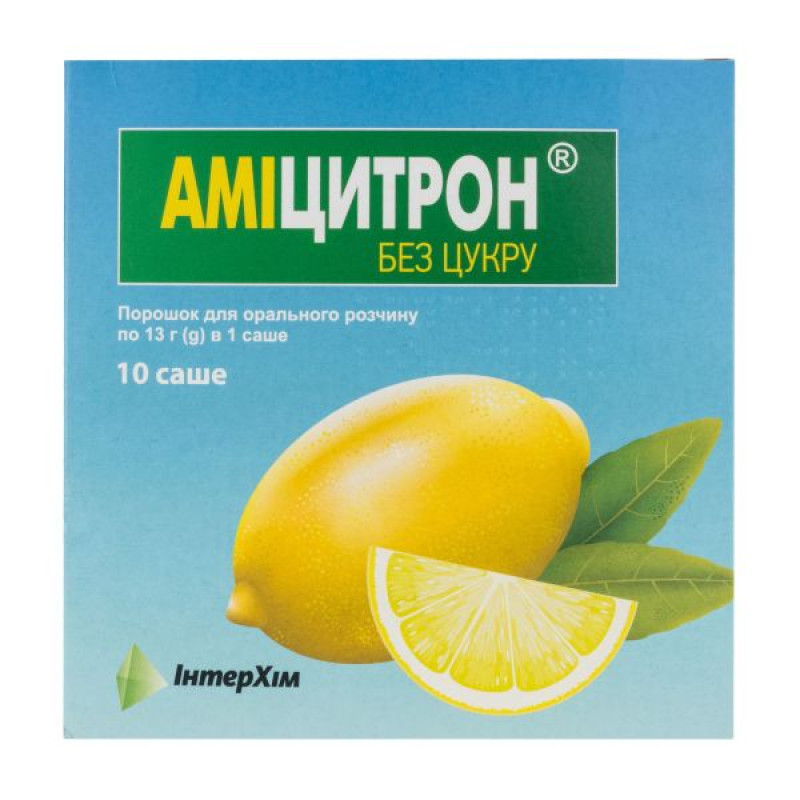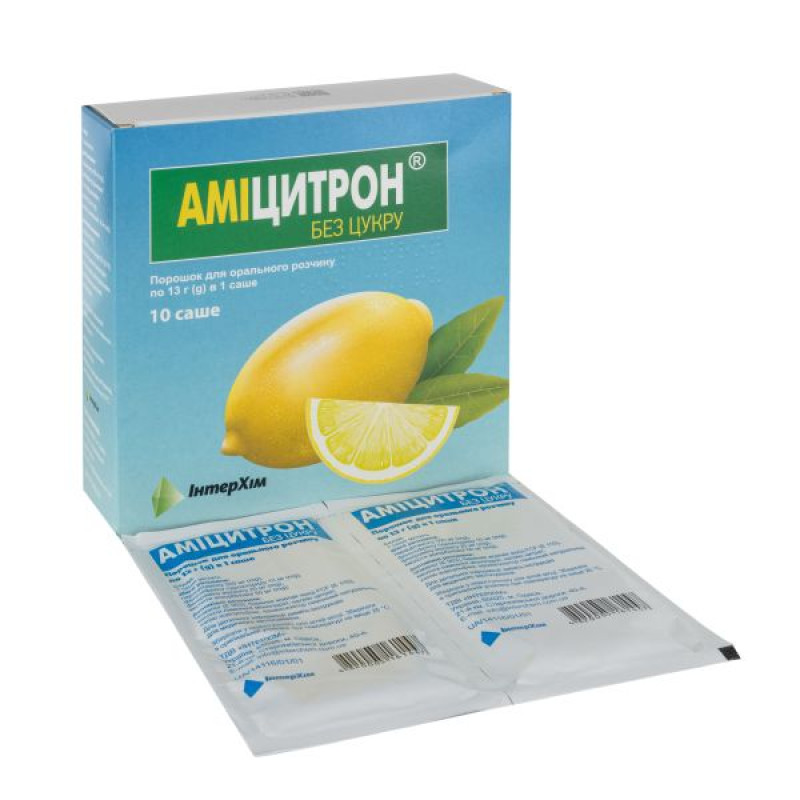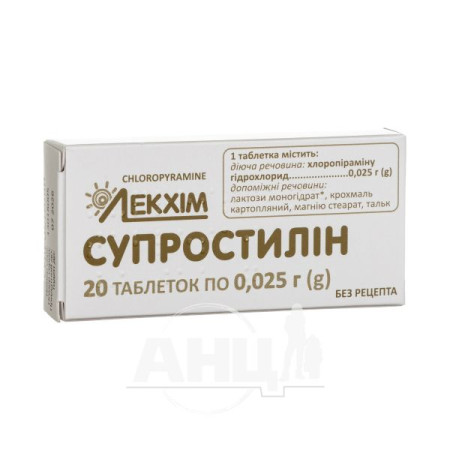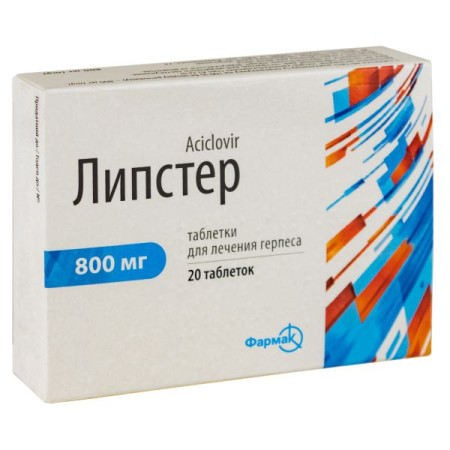Amicitron sugar-free powder for oral solution sachet 13 g No. 10
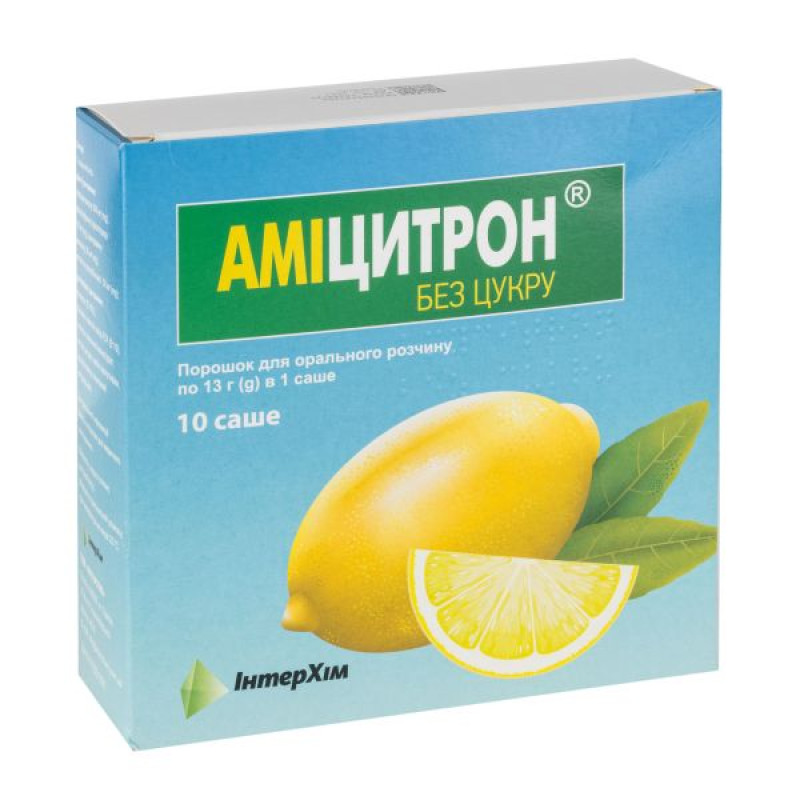
Instructions Amicitron sugar-free powder for oral solution sachet 13 g No. 10
Composition
active ingredients: paracetamol, phenylephrine hydrochloride, pheniramine maleate, ascorbic acid.
1 sachet contains paracetamol 500 mg, phenylephrine hydrochloride 10 mg, pheniramine maleate 20 mg, ascorbic acid 50 mg;
excipients: isomalt (E 953), sunset yellow FCF dye (E 110), citric acid monohydrate, sodium citrate, acesulfame potassium, natural lemon flavor.
Dosage form
Powder for oral solution.
Main physicochemical properties: white powder, in which inclusions of pale yellow and/or orange color are allowed.
Pharmacotherapeutic group
Analgesics and antipyretics. Paracetamol, combinations without psycholeptics. ATX code N02B E51.
Pharmacological properties
Pharmacodynamics.
Paracetamol has antipyretic, analgesic and anti-inflammatory effects. It inhibits the synthesis of prostaglandins in the central nervous system and blocks the conduction of pain impulses.
Phenylephrine hydrochloride is an α-adrenomimetic, has a vasoconstrictor effect, reduces swelling of the nasal mucosa and paranasal sinuses.
Pheniramine maleate is a histamine H1 receptor blocker that reduces vascular permeability, eliminates tearing, and itching of the eyes and nose.
Ascorbic acid enhances the body's nonspecific resistance.
Pharmacokinetics.
Paracetamol is well absorbed, penetrates the placental barrier, enters breast milk to a small extent, is metabolized in the liver by the cytochrome P450 system, is excreted by the kidneys, the half-life is 1-4 hours. The duration of action is 3-4 hours.
The action of phenylephrine hydrochloride occurs quickly and lasts about 20 minutes. Phenylephrine hydrochloride is metabolized in the liver or in the digestive tract, excreted by the kidneys.
Pheniramine maleate is well absorbed from the digestive tract, metabolized in the liver by the cytochrome P450 system, excreted by the kidneys, the half-life is 16-18 hours.
Ascorbic acid is rapidly absorbed from the digestive tract, metabolized in the liver, and excreted by the kidneys.
Indication
Treatment of symptoms of acute respiratory infections and influenza: fever, headache, nasal congestion, runny nose, pain and muscle aches.
Contraindication
Hypersensitivity to the components of the drug; pyloroduodenal obstruction; acute pancreatitis; severe liver and/or kidney dysfunction; congenital hyperbilirubinemia (including Gilbert's syndrome); glucose-6-phosphate dehydrogenase deficiency; hyperthyroidism; prostatic hypertrophy with urinary retention; bladder neck obstruction; severe forms of arrhythmia, arterial hypertension, atherosclerosis, ischemic heart disease; blood diseases (including leukopenia, severe anemia); thrombosis; thrombophlebitis; bronchial asthma; angle-closure glaucoma; epilepsy; alcoholism; states of increased excitement; concomitant treatment with MAO inhibitors and the period within 2 weeks after their discontinuation.
Interaction with other medicinal products and other types of interactions
The rate of absorption of paracetamol may increase with the use of metoclopramide and domperidone and decrease with the use of cholestyramine. Barbiturates reduce the antipyretic effect of paracetamol. Anticonvulsants (including phenytoin, barbiturates, carbamazepine), which stimulate the activity of liver microsomal enzymes, may enhance the toxic effect of paracetamol on the liver due to an increase in the degree of its conversion to hepatotoxic metabolites. With the simultaneous use of paracetamol with hepatotoxic drugs, the toxic effect of drugs on the liver increases. Simultaneous use of high doses of paracetamol with isoniazid increases the risk of developing hepatotoxic syndrome. The anticoagulant effect of warfarin and other coumarins may be enhanced with simultaneous long-term regular daily use of paracetamol with an increased risk of bleeding; periodic administration has no significant effect. Paracetamol reduces the effectiveness of diuretics. Do not use simultaneously with alcohol.
The interaction of phenylephrine hydrochloride with MAO inhibitors causes a hypertensive effect, with tricyclic antidepressants (amitriptyline) - increases the risk of cardiovascular side effects, with digoxin and cardiac glycosides - leads to arrhythmias and heart attack. Phenylephrine hydrochloride with other sympathomimetics increases the risk of adverse cardiovascular reactions, may reduce the effectiveness of β-blockers and other antihypertensive drugs (reserpine, methyldopa) with an increased risk of arterial hypertension and adverse cardiovascular reactions.
Ascorbic acid when taken orally enhances the absorption of penicillin, iron, reduces the effectiveness of heparin and indirect anticoagulants, increases the risk of crystalluria in treatment with salicylates and the risk of glaucoma in treatment with glucocorticosteroids, large doses reduce the effectiveness of tricyclic antidepressants. Antidepressants, antiparkinsonian and antipsychotic drugs, phenothiazine derivatives increase the risk of urinary retention, dry mouth, constipation. Ascorbic acid can be taken only 2 hours after the injection of deferoxamine, since their simultaneous administration increases iron toxicity, especially in the myocardium. Long-term administration of large doses during treatment with disulfiram inhibits the disulfiram-alcohol reaction.
Application features
Do not exceed the recommended doses. In case of overdose, consult a doctor immediately due to the risk of liver damage, even if the patient feels well.
If you have been told you have an intolerance to some sugars, contact your doctor before taking this medicine. Due to the content of isomalt (E 953), the medicine should not be taken by patients with rare hereditary problems of fructose intolerance. 1 sachet of Amicitron® sugar-free contains 10.4 g of isomalt, so the medicine may have a mild laxative effect. The energy value of 1 g of isomalt is 2.3 kcal. 1 sachet of Amicitron® sugar-free contains 3.5 mmol (or 80 mg) of sodium, so patients on a controlled sodium diet should use this medicine with caution. The medicine contains the colouring agent sunset yellow FCF (E 110), which may cause allergic reactions.
Do not use simultaneously with other drugs intended for the symptomatic treatment of colds and rhinitis (vasoconstrictors, paracetamol-containing). Patients with mild arthritis who take analgesics every day, and patients who use warfarin or similar drugs that have an anticoagulant effect, should consult a doctor before using the drug.
Patients with severe infections such as sepsis, which are accompanied by a decrease in glutathione levels, are at increased risk of metabolic acidosis when taking paracetamol. Symptoms of metabolic acidosis include deep, rapid or difficult breathing, nausea, vomiting, loss of appetite. You should seek immediate medical attention if these symptoms occur.
In case of liver or kidney diseases, it is necessary to consult a doctor before using the drug. It should be borne in mind that patients with alcoholic non-cirrhotic liver damage are at increased risk of hepatotoxic effects of paracetamol.
Use with caution in Raynaud's disease, arterial hypertension, heart disease, arrhythmias (bradycardia, etc.), prostatic hypertrophy, pheochromocytoma, thyroid, liver and kidney diseases, glaucoma, chronic lung diseases and the elderly. The drug contains phenylephrine hydrochloride, which can cause angina attacks.
The drug may affect the results of laboratory tests for blood glucose and uric acid.
If symptoms persist (especially if the headache becomes persistent), you should consult a doctor.
Long-term use of the drug without consulting a doctor can be dangerous.
Use during pregnancy or breastfeeding
Not used.
Ability to influence reaction speed when driving vehicles or other mechanisms
When using the drug, it is not recommended to drive a car or operate other complex mechanisms, as the drug may cause drowsiness.
Method of administration and doses
The drug is prescribed for adults and children over 14 years of age. The drug is taken orally in the form of a solution. Dissolve the contents of the sachet in a glass of hot water (not boiling water). It can be taken every 3-4 hours, but no more than 3 sachets per day. The maximum period of use without consulting a doctor is 3 days, further use is recommended by a doctor.
Children
The medicine is not used in children under 14 years of age.
Overdose
Symptoms of paracetamol overdose in the first 24 hours: pallor, nausea, vomiting, loss of appetite and abdominal pain. Liver damage may become apparent 12-48 hours after overdose. Glucose metabolism disorders and metabolic acidosis may occur. In severe poisoning, liver failure may progress to encephalopathy, hemorrhage, hypoglycemia, coma and death. Acute renal failure with acute tubular necrosis may present with severe lumbar pain, hematuria, proteinuria and may develop even in the absence of severe liver damage. Cardiac arrhythmias and pancreatitis have also been reported.
With prolonged use of paracetamol in large doses, aplastic anemia, pancytopenia, agranulocytosis, leukopenia (including neutropenia), thrombocytopenia may develop from the hematopoietic system. When taking large doses, dizziness, psychomotor agitation, disorientation, sleep disturbances are possible from the central nervous system; from the urinary system - nephrotoxicity (renal colic, interstitial nephritis, papillary necrosis).
In case of overdose, immediate medical attention is required. The patient should be taken to hospital immediately, even if there are no early symptoms of overdose. Symptoms may be limited to nausea and vomiting or may not reflect the severity of the overdose or the risk of organ damage.
Activated charcoal should be considered if paracetamol overdose has been taken within 1 hour. Plasma paracetamol concentrations should be measured 4 hours or later after ingestion (earlier concentrations are unreliable). N-acetylcysteine treatment can be used up to 24 hours after ingestion of paracetamol, but the maximum protective effect is achieved when it is used within 8 hours of ingestion. The effectiveness of the antidote decreases sharply after this time. If necessary, the patient should be given intravenous N-acetylcysteine according to the recommended doses. In the absence of vomiting, oral methionine can be used as a suitable alternative in remote areas outside the hospital.
Overdose of phenylephrine causes hyperhidrosis, psychomotor agitation or depression of the central nervous system, headache, dizziness, drowsiness, impaired consciousness, arrhythmias, tremor, hyperreflexia, convulsions, nausea, vomiting, irritability, anxiety, and arterial hypertension.
In case of an overdose of pheniramine, atropine-like symptoms occur: mydriasis, photophobia, dry skin and mucous membranes, hyperthermia, intestinal atony. Central nervous system depression leads to disruption of the respiratory and cardiovascular systems (bradycardia, arterial hypotension, collapse).
An overdose of ascorbic acid causes nausea, vomiting, bloating and abdominal pain, itching, skin rashes, increased excitability. Doses over 3000 mg can cause temporary osmotic diarrhea and gastrointestinal disorders, zinc and copper metabolism disorders, myocardial dystrophy, glucosuria, crystalluria, nephrolithiasis.
Treatment: symptomatic therapy. Within 6 hours after overdose, gastric lavage should be performed, and within the first 8 hours, methionine should be administered orally or cysteamine or N-acetylcysteine should be administered intravenously.
Adverse reactions
Skin and subcutaneous tissue disorders: dermatitis.
On the part of the immune system: anaphylaxis, hypersensitivity reactions, including skin itching, rash on the skin and mucous membranes (usually generalized rash, erythematous, urticaria), angioedema, erythema multiforme exudative (including Stevens-Johnson syndrome), toxic epidermal necrolysis (Lyell's syndrome).
From the nervous system: headache, dizziness, tremor, psychomotor agitation and disorientation, anxiety, nervous excitement, feeling of fear, irritability, sleep disturbances, insomnia, drowsiness, confusion, hallucinations, depressive states, paresthesia, tinnitus; in some cases - coma, convulsions, dyskinesia, behavioral changes.
On the part of the organs of vision: impaired vision and accommodation, mydriasis, increased intraocular pressure, dry eyes.
Respiratory system: bronchospasm in patients sensitive to acetylsalicylic acid and other nonsteroidal anti-inflammatory drugs (NSAIDs).
On the part of the digestive tract: nausea, vomiting, heartburn, dry mouth, discomfort and pain in the epigastric region, constipation, diarrhea, flatulence, anorexia, aphthae, hypersalivation, hemorrhages.
On the part of the hepatobiliary system: impaired liver function, increased activity of liver enzymes, usually without the development of jaundice, hepatonecrosis (when using high doses).
On the part of the endocrine system: hypoglycemia, up to hypoglycemic coma.
From the urinary system: nephrotoxicity, interstitial nephritis, papillary necrosis, dysuria, urinary retention and difficulty urinating, aseptic pyuria.
Cardiovascular system: arterial hypertension, arrhythmias (tachycardia, bradycardia, etc.), shortness of breath, pain in the heart area.
From the blood and lymphatic system: anemia (including hemolytic anemia), sulfhemoglobinemia and methemoglobinemia (cyanosis, shortness of breath, pain in the heart area), thrombocytopenia, agranulocytosis, bleeding, bruising.
Others: general weakness.
Expiration date
3 years.
Storage conditions
Store in the original packaging at a temperature not exceeding 25 °C.
Keep out of reach of children.
Packaging
Powder for oral solution, 13 g, in sachet No. 1.
Powder for oral solution, 13 g per sachet; 10 sachets per carton.
Vacation category
Without a prescription.
Producer
Additional Liability Company "INTERCHEM".
Location of the manufacturer and address of its place of business
Ukraine, 65080, Odesa region, Odessa, Lustdorfska road, building 86.
There are no reviews for this product.
There are no reviews for this product, be the first to leave your review.
No questions about this product, be the first and ask your question.







